You can effectively track sleep disturbances using wearable devices that monitor movement, heart rate, and physiological signals through accelerometers and PPG sensors. Top options include the Oura Ring 4 with extensive wellness tracking, Samsung Galaxy Ring with snore detection, and Whoop 4.0 Band offering detailed analytics. These devices identify every awakening, measure sleep efficiency, and track heart rate variability to reveal disturbance patterns. Prices range from $69 to $400, and exploring their advanced features will help you choose the perfect sleep monitoring solution.
Understanding Sleep Disturbances and Their Impact on Health
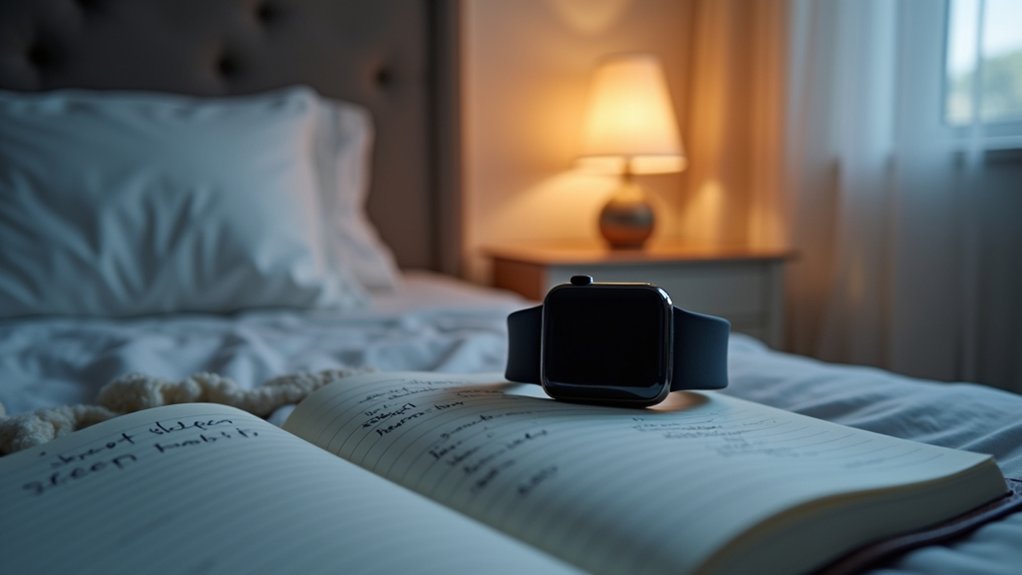
Since sleep affects nearly every aspect of your health, understanding sleep disturbances becomes essential for recognizing their far-reaching impact on your daily life. Over 80 different sleep disorders can disrupt your rest, with insomnia being the most common.
Sleep disorders extend far beyond nighttime disruption, creating a cascade of health consequences that affect every area of your waking life.
You’ll likely experience difficulty falling asleep, frequent awakenings, or daytime fatigue that impairs your concentration and performance. These disturbances don’t just affect your nights—they’ll trigger headaches, weaken your immune system, and increase your risk of cardiovascular problems.
You might notice increased irritability, anxiety, or depression as fragmented sleep disrupts hormone regulation. Sleep disorders often worsen chronic conditions like hypertension and diabetes while contributing to weight gain and metabolic dysfunction.
Your reaction time suffers, making accidents more likely, and social relationships may deteriorate as persistent sleep problems reduce your quality of life. More than 50 million Americans currently live with a diagnosed sleep disorder, highlighting the widespread nature of these health challenges.
How Wearable Sleep Trackers Detect Sleep Pattern Irregularities
When you wear a sleep tracker, multiple sophisticated sensors work together to detect movement, heart rate changes, and other physiological signals that reveal irregularities in your sleep patterns.
Accelerometers serve as the primary sensor, tracking three-dimensional movement to distinguish between sleep and wake states. Photoplethysmography (PPG) sensors monitor blood volume changes to assess heart rate variations, while electrodermal activity sensors detect stress-related skin conductance changes. These measurements are indirect estimates since wearable trackers cannot directly measure brain activity like clinical sleep studies.
Your tracker’s proprietary algorithms interpret this raw data to identify specific irregularities:
- Fragmented sleep – detected through multiple short wake episodes via accelerometry and PPG signals
- Prolonged wake periods – identified by increased movement and heart rate spikes during typical sleep hours
- Delayed sleep onset – measured by detecting when inactivity periods begin relative to your normal sleep window
- Stress-related arousals – flagged through electrodermal activity changes indicating anxiety or disturbances
Top-Rated Sleep Tracking Devices for Disturbance Monitoring
When you’re selecting a sleep tracker for disturbance monitoring, you’ll want to compare devices based on their advanced monitoring capabilities and overall performance.
The market offers everything from budget-friendly wrist trackers to premium smart rings with sophisticated sensors that can detect subtle sleep pattern irregularities.
Understanding how different devices stack up against each other with respect to accuracy, features, and usability will help you choose the right tool for tracking your specific sleep disturbances. Recent tariff increases may lead to approximately 20% price hikes for consumer electronics including wearables, potentially affecting your purchasing timeline and budget considerations.
Advanced Monitoring Features
Today’s top-rated sleep tracking devices incorporate sophisticated monitoring technologies that go far beyond basic step counting to deliver detailed sleep disturbance analysis.
These advanced features provide extensive insights into your sleep patterns and potential health risks.
Key monitoring capabilities include:
- Brain Activity Tracking – Devices using fNIRS technology monitor brain activity during sleep stages, while neurofeedback features guide you into deeper, more restful sleep through real-time brainwave feedback.
- Movement Analysis – 3-axis accelerometers detect motion patterns, converting movement data into activity counts that identify sleep fragmentation and restless periods throughout the night.
- Breathing Monitoring – FDA-cleared sensors detect sleep apnea and breathing irregularities, measuring respiration rate and variability to identify central and obstructive sleep events.
- Environmental Integration – Advanced trackers monitor room temperature, humidity, and noise levels, correlating environmental factors with sleep disturbances for personalized optimization recommendations. Many devices also track blood glucose levels to understand how metabolic fluctuations impact sleep quality.
Device Comparison Overview
Which sleep tracking device will best address your specific disturbance monitoring needs?
The Oura Ring 4 excels with its comfortable, lightweight design and thorough wellness tracking, including sleep stages and stress indicators.
Samsung Galaxy Ring offers snore detection while being lighter than Oura, perfect for Android users.
Whoop 4.0 Band delivers detailed analytics with HRV and respiratory monitoring, though requiring frequent charging.
Fitbit Inspire 3 provides an affordable, user-friendly option with 10-day battery life.
For maximum accuracy, Muse S uses EEG technology but sacrifices comfort with its headband design. Wearable trackers generally provide better accuracy than non-wearable options due to improved skin contact.
Withings Sleep Tracking Mat eliminates wearables entirely, monitoring through under-mattress sensors while tracking heart rate, movements, and snoring patterns.
Oura Ring 4: Advanced Sleep Staging and Disturbance Detection
Although sleep tracking devices have proliferated in recent years, the Oura Ring 4 distinguishes itself through sophisticated sensor integration and precise physiological monitoring that transforms how you understand your sleep patterns.
The device’s 18-path multi-wavelength PPG technology combines with multiple sensors to deliver thorough sleep analysis:
Advanced 18-path multi-wavelength PPG technology works alongside multiple integrated sensors to provide comprehensive and detailed sleep analysis capabilities.
- Multi-stage sleep detection – Accurately distinguishes between awake, light, deep, and REM stages using heart rate, HRV, respiration, temperature, and movement data.
- Blood oxygen monitoring – Red and infrared LEDs detect SpO2 drops that may indicate sleep-disordered breathing events.
- Disturbance identification – Accelerometer data captures restlessness while temperature shifts signal illness or environmental disruptions.
- Personalized insights – Advanced algorithms adapt to your unique physiology, improving accuracy and delivering actionable sleep recommendations over time. The device’s fully titanium construction and recessed sensors provide enhanced comfort during extended wear, supporting consistent overnight monitoring without interference.
RingConn Sleep Tracker: Comprehensive Metrics and Apnea Detection
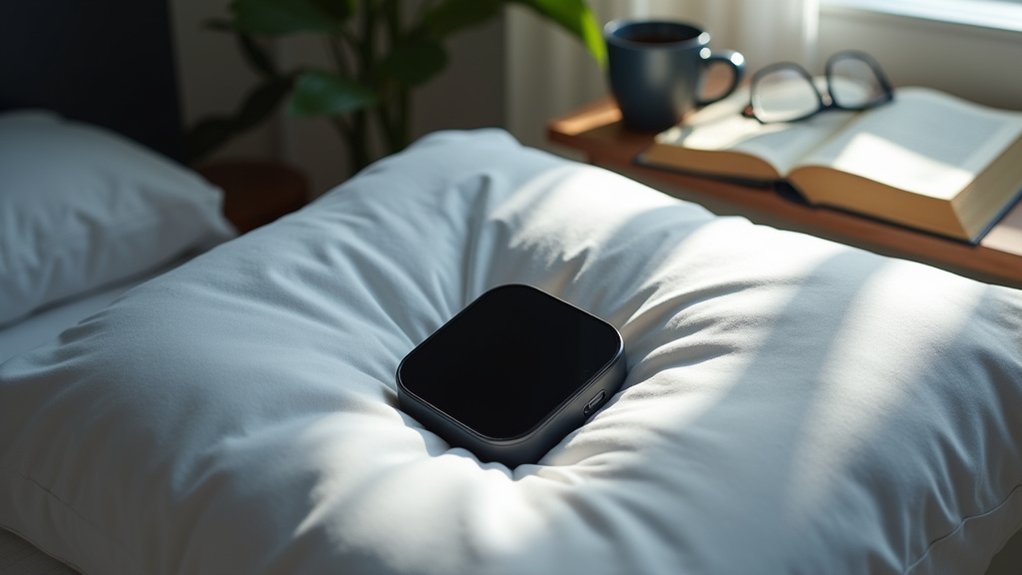
While most sleep trackers focus on basic metrics, the RingConn Gen 2 revolutionizes nighttime monitoring by integrating extensive sleep analysis with dedicated sleep apnea detection—addressing a critical health condition that affects over 1 billion people worldwide yet remains undiagnosed in 80% of cases.
You’ll receive continuous monitoring every 2.5 minutes throughout the night, tracking heart rate, HRV, and SpO2 with 90.7% accuracy. The ultra-thin 2mm design won’t disrupt your sleep while delivering comprehensive data including skin temperature and respiratory rate.
| Feature | Measurement | Accuracy |
|---|---|---|
| Sleep Apnea Detection | AHI/ODI Index | 90.7% |
| SpO2 Monitoring | Every 2 seconds | High precision |
| Battery Life | 12 days | Continuous tracking |
| Health Metrics | HR/HRV/Temperature | Multi-dimensional |
The AI-powered system generates personalized insights and a daily sleep score out of 100, making complex data digestible. The device tracks sleep patterns including time spent in REM, Light, and Deep sleep stages for complete sleep architecture analysis.
Whoop 4.0: Recovery-Focused Sleep and Disturbance Analysis
The Whoop 4.0 stands out by prioritizing recovery analysis over basic sleep tracking, making it particularly valuable if you’re an athlete or fitness enthusiast dealing with sleep disturbances.
You’ll get thorough recovery metrics that correlate your sleep quality, heart rate variability, and physiological strain to understand how disturbances impact your body’s ability to recover. The device tracks all four sleep stages with high accuracy, providing detailed insights into SWS, REM, light, and awake phases to identify specific disruption patterns.
This recovery-focused approach helps you optimize both your sleep patterns and athletic performance by identifying specific disturbances that compromise your training readiness.
Recovery Metrics Overview
Recovery sits at the heart of WHOOP 4.0’s sleep monitoring approach, transforming how you understand your body’s nightly restoration process.
The device’s Sleep Performance Score combines multiple factors to deliver thorough sleep quality insights, while lab-level accuracy tracks your sleep stages including awake, light, REM, and deep sleep phases.
WHOOP’s recovery monitoring system focuses on four critical metrics:
- Heart Rate Variability (HRV) – Measures how well your body adapts to stress
- Resting Heart Rate – Tracks cardiovascular recovery during sleep
- Respiratory Rate – Monitors breathing patterns impacting restoration
- Sleep Stress – Quantifies high-stress periods disrupting recovery
These biometric data points work together to generate your daily Recovery Score, indicating whether you’re ready for intense activity or need additional rest to optimize performance. When technical difficulties arise, users should refresh the page or report issues to maintain consistent access to their recovery insights.
Sleep Disturbance Detection
Beyond basic sleep tracking, WHOOP 4.0’s disturbance detection system identifies every awakening and restless period that fragments your nightly recovery.
The device’s enhanced sensor array—four photodiodes and five LEDs—monitors heart rate, HRV, and movement at 100 samples per second to pinpoint when you’re truly asleep versus restless.
You’ll receive detailed breakdowns showing exactly when disturbances occurred and their duration throughout the night.
The integrated SpO2 sensor catches breathing-related disruptions like sleep apnea, while skin temperature monitoring detects circadian rhythm shifts that affect sleep quality.
Your Sleep Details screen displays disturbance scores alongside sleep efficiency metrics, revealing how fragmented sleep impacts next-day recovery. Users can access troubleshooting resources if they encounter any issues with their sleep tracking functionality.
This data helps you identify patterns and triggers that consistently disrupt your rest.
Athletic Performance Analysis
While basic fitness trackers count steps and estimate calories, WHOOP 4.0 transforms sleep data into actionable athletic intelligence through its recovery-focused analysis system.
You’ll receive a daily recovery score that combines sleep quality, HRV, resting heart rate, and respiratory rate to guide your training decisions.
The system’s athletic performance analysis includes:
- Recovery-Based Training Guidance – Your daily score tells you whether to push hard or prioritize rest
- Sleep Stage Breakdown – Detailed analysis of light, deep, and REM sleep for muscle recovery optimization
- HRV Monitoring – Continuous tracking of this key biomarker indicates your autonomic nervous system balance
- Strain-Recovery Balance – Data-driven insights help prevent overtraining and reduce injury risk
This thorough approach enables you to make informed decisions about training intensity based on your body’s actual recovery status. The device achieves 99.7% accuracy in heart rate measurement during sleep, providing reliable data for recovery calculations.
Samsung Galaxy Ring: AI-Powered Sleep Disturbance Insights
The Samsung Galaxy Ring represents a breakthrough in sleep disturbance monitoring through its sophisticated AI-powered analysis system.
You’ll benefit from advanced algorithms that process multiple biometric signals including heart rate variability, blood oxygen levels, skin temperature, and movement patterns to identify sleep disruptions.
The ring’s multi-sensor approach detects breathing irregularities, snoring episodes, and stress-related disturbances that single metrics might miss. You can track sleep stages, blood oxygen dips, and autonomic nervous system imbalances through continuous monitoring.
Data automatically syncs to Samsung Health, where you’ll receive AI-generated insights and personalized recommendations. The visual sleep graphs help you understand disturbance timing and causes, enabling lifestyle adjustments to improve sleep quality through thorough, clinically-relevant wellness monitoring. You can access all recorded sleep information, including detailed sleep time analysis, directly through the Galaxy Wearable app on your phone.
Key Sleep Metrics That Reveal Disturbance Patterns
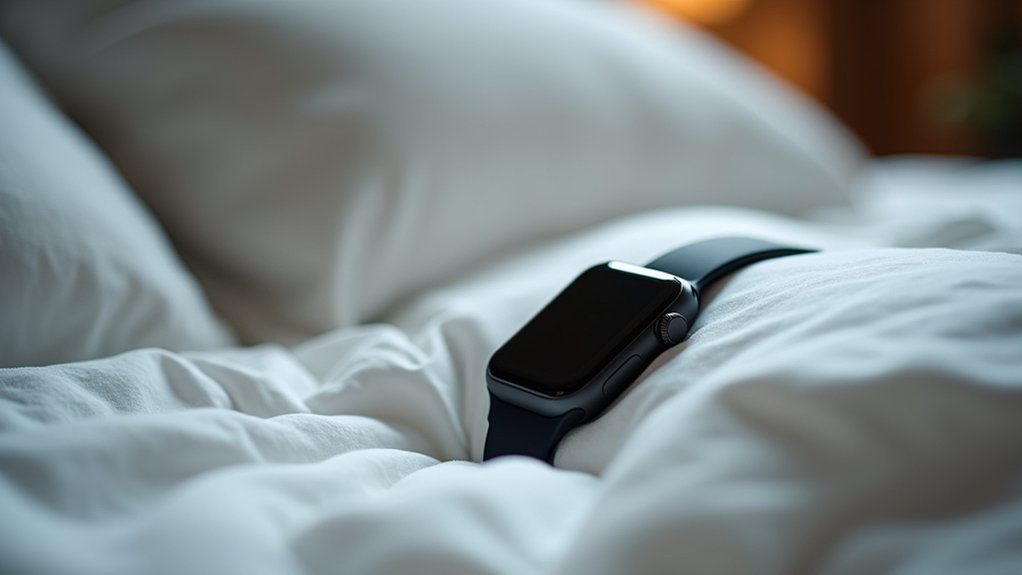
Your wearable device tracks several critical metrics that can expose hidden sleep disturbance patterns affecting your nightly rest.
When your sleep stages become fragmented with frequent changes between light, deep, and REM phases, it’s often the first sign of underlying issues disrupting your natural sleep architecture.
Additionally, your heart rate variability during sleep and increased movement or restlessness throughout the night provide valuable clues about stress, breathing problems, or environmental factors that might be sabotaging your sleep quality. However, many consumer devices struggle with misclassification of wakefulness during sleep periods, which can affect the accuracy of your sleep disturbance assessments.
Sleep Stage Disruptions
When tracking sleep disturbances, wearable devices analyze your sleep architecture through sophisticated algorithms that identify distinct sleep stages with varying degrees of accuracy.
Modern wearables achieve 50-86% sensitivity in sleep stage detection, with devices like the Oura Ring reaching 76-79.5% accuracy. These devices output data in 30-second to 1-minute intervals, providing detailed insights into your sleep disruption patterns.
Your wearable detects four critical sleep stage disruptions:
- Reduced deep sleep (N3) duration – Indicates compromised physical recovery and muscle repair processes
- REM sleep alterations – Suggests cognitive impairment or stress-related disturbances
- Frequent stage shifts – Reveals underlying disruption patterns affecting sleep continuity
- Disproportionate light sleep increases – Signals less restorative sleep and overall disturbance
Professional cyclists utilizing wearable technology during competitions like the Tour de France maintain an average sleep efficiency of 87%, demonstrating how consistent monitoring can optimize recovery despite challenging conditions.
Heart Rate Variability
While your wearable tracks sleep stages, it’s simultaneously monitoring heart rate variability (HRV) – the subtle variation in time between each heartbeat that reveals critical insights about your autonomic nervous system’s response to sleep disturbances.
During healthy NREM sleep, you’ll see higher HRV as your parasympathetic nervous system dominates, promoting recovery. However, REM sleep typically shows lower HRV due to sympathetic activation.
When sleep disorders like obstructive sleep apnea occur, your HRV drops considerably due to frequent arousals disrupting normal patterns.
Your wearable uses PPG sensors to detect these variations, alerting you to potential issues. Consistently low HRV during sleep often indicates poor sleep quality, stress, or underlying health conditions requiring attention. Research shows that day-night differences in HRV become blunted or reversed in patients with cardiopulmonary diseases, suggesting reduced adaptive capacity compared to healthy individuals.
Movement and Restlessness
Beyond heart rate patterns, the accelerometer in your wearable device captures every toss, turn, and micro-movement throughout the night, creating a detailed map of your physical restlessness that often reveals hidden sleep disturbances.
Your device tracks movement-related metrics that indicate sleep quality disruption:
- Sleep efficiency – The percentage of time you’re actually sleeping versus lying awake motionless
- Wake after sleep onset (WASO) – Movement bursts that signal mid-sleep awakenings
- Restlessness episodes – Frequent micro-movements indicating fragmented sleep continuity
- Movement intensity patterns – Changes that help distinguish between light and deep sleep stages
However, movement tracking has limitations.
You’ll find devices often misclassify still wakefulness as sleep, underestimate disturbances in low-movement individuals, and struggle with accuracy in people experiencing insomnia or sleep apnea.
Comfort and Design Features for Continuous Sleep Monitoring
Since sleep tracker comfort directly impacts both consistent use and data accuracy, choosing a device with the right design features becomes essential for effective continuous monitoring.
Uncomfortable sleep trackers lead to inconsistent wear and poor data quality, making comfort the top priority for effective monitoring.
You’ll want to prioritize soft, lightweight silicone materials that won’t disrupt your sleep or cause discomfort during all-night wear. Heavy or stiff materials often lead to device removal and inconsistent data collection.
Slim wristbands and smart rings minimize bulk while reducing sleep disturbance. Look for flat sensors and minimalistic designs that eliminate pressure points, with adjustable straps ensuring your device stays securely positioned without being too tight.
Rings typically disturb sleep less than bulky wrist-worn devices. Choose trackers with hypoallergenic materials and flexible bands that adapt to your body’s contours. Many models now include water resistance features that enhance durability without compromising comfort during extended wear.
Extended battery life—ideally over a week—reduces charging interruptions and maintains continuous monitoring without daily maintenance requirements.
Analyzing Sleep Data to Identify Chronic Disturbance Issues
Once you’ve established consistent sleep monitoring with your comfortable wearable device, the real value emerges through systematically analyzing the collected data to spot chronic disturbance patterns.
Your wearable’s continuous 24/7 monitoring creates a thorough sleep profile that reveals issues traditional methods might miss.
You’ll need to focus on specific analytical approaches to identify persistent problems:
- Track sleep efficiency trends over weeks to detect declining sleep quality patterns
- Monitor night-to-night variability in sleep onset and wake times as stress indicators
- Analyze wake after sleep onset (WASO) frequency to identify fragmented sleep issues
- Compare your baseline metrics against current data to spot gradual deterioration
Remember that wearables have varying accuracy compared to polysomnography, so you’re looking for consistent trends rather than precise measurements. Understanding the limitations helps prevent mistaking stillness for sleep when analyzing data from periods when you may have been lying awake but motionless.
Cost Comparison and Subscription Models for Sleep Trackers
Budget considerations play an essential role when selecting a sleep tracker that’ll serve your long-term monitoring needs. Most wearable sleep trackers fall between $100 and $400, with budget options like SLEEPON starting at $69 and Fitbit Inspire 3 under $150.
Sleep tracker prices typically range from $69 to $400, making budget planning crucial for your long-term sleep monitoring investment.
You’ll face two main cost structures: one-time purchases versus subscription models. RingConn offers lifetime data access at $299 without ongoing fees, while devices like Whoop require continuous subscriptions that can exceed the initial device cost over time.
Oura Ring starts at $249 but demands membership fees for full functionality.
Consider hidden costs too—replacement batteries, premium app features, and subscription renewals add up. For balanced value, Fitbit Charge 4 at $130 combines sleep and fitness tracking effectively without mandatory subscriptions. The Xiaomi Mi Band 6 provides exceptional value with over two weeks of battery life between charges.
Improving Sleep Quality Using Wearable Technology Insights
While wearable devices excel at collecting sleep data, transforming those insights into meaningful improvements requires understanding what the metrics actually reveal about your rest quality. Your device tracks key measurements like sleep efficiency, total sleep time, and stages, but you’ll often notice subjective improvements before objective changes appear in the data.
Here’s how to leverage your wearable’s insights effectively:
- Focus on sleep onset latency – Studies show wearables can objectively reduce the time it takes you to fall asleep.
- Track subjective improvements – Your perceived sleep quality often improves more dramatically than measurable metrics.
- Use integrated feedback features – Goal-based gaming and social support help establish better sleep habits.
- Monitor trends over time – Individual nights vary, but patterns reveal actionable insights about your sleep quality.
Given that sleep disturbances affect 50% of adults, incorporating wearable technology into sleep monitoring strategies becomes increasingly valuable for addressing this widespread public health concern.
Frequently Asked Questions
Can Wearable Sleep Trackers Interfere With Wifi or Bluetooth Devices?
You’ll rarely experience interference since sleep trackers use low-power Bluetooth signals designed to coexist with other devices. However, you might notice occasional connection issues in crowded wireless environments with multiple competing signals.
Are Sleep Trackers Safe for People With Pacemakers or Implants?
Sleep trackers aren’t always safe if you’ve got a pacemaker or ICD. Magnets and bioimpedance sensors can interfere with your device’s function. Keep wearables at least six inches from your implant site.
How Do I Clean and Maintain My Wearable Sleep Tracker?
Turn off your device before cleaning. Use a damp microfiber cloth on the screen, avoiding harsh chemicals. Clean straps with mild soap and water, then dry thoroughly to prevent damage.
Can Multiple Family Members Share One Sleep Tracking Device Account?
You shouldn’t share one sleep tracking device account among family members. Most wearables are designed for individual use, and sharing accounts creates inaccurate data and privacy concerns for everyone involved.
Do Sleep Trackers Work Accurately for Shift Workers or Travelers?
Sleep trackers work less accurately for shift workers since they’re designed for standard schedules. You’ll get better results as a traveler, but expect reduced precision during circadian disruption periods.
In Summary
You’ve got the tools to take control of your sleep health through wearable technology. Whether you choose the Oura Ring 4’s advanced staging or RingConn’s apnea detection, you’re investing in better rest. Don’t just collect data—act on it. Track your patterns, identify disturbances, and adjust your habits accordingly. Your sleep tracker’s only as valuable as the changes you make based on its insights. Start monitoring tonight and wake up to better health tomorrow.

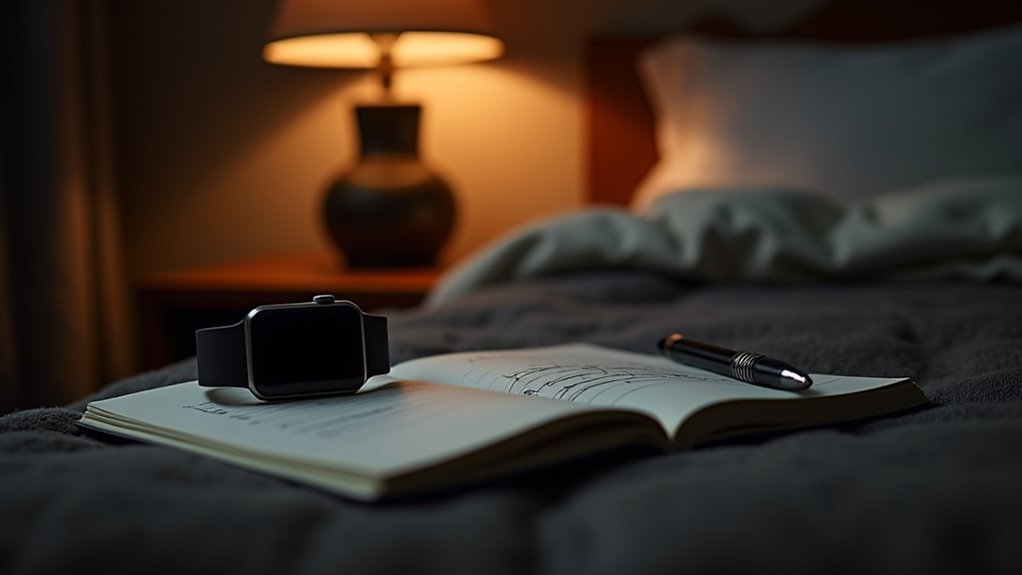
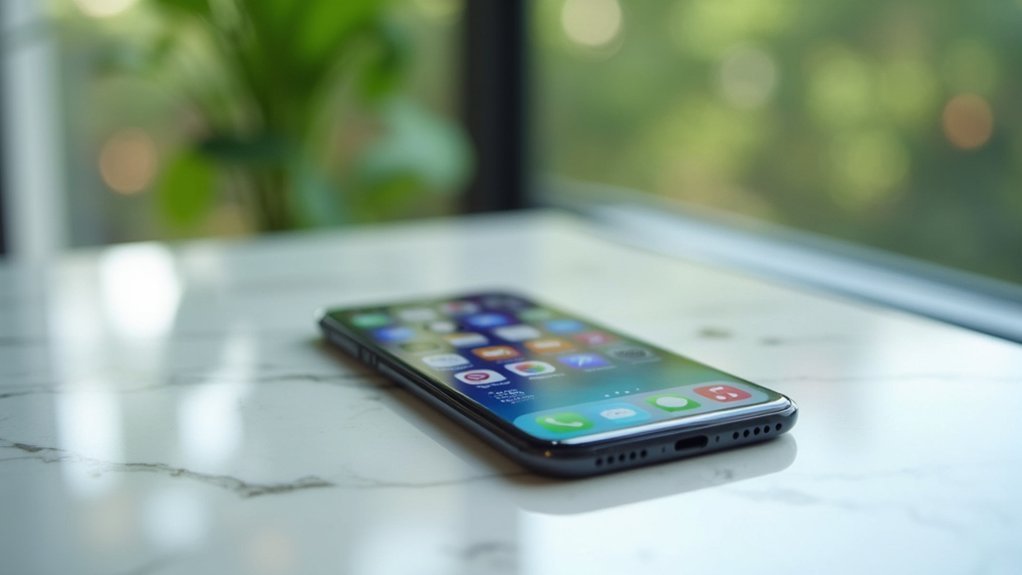
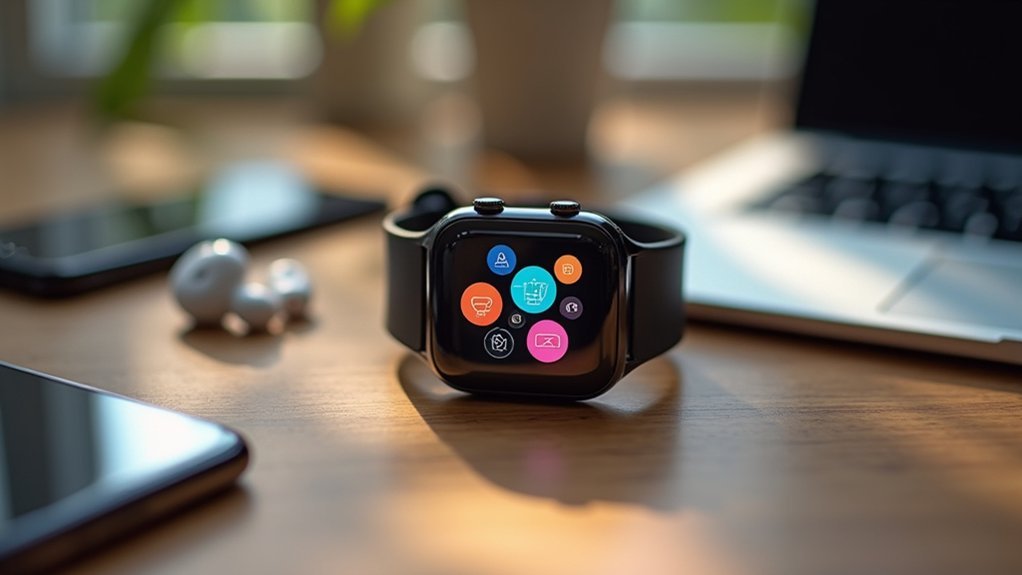

Leave a Reply